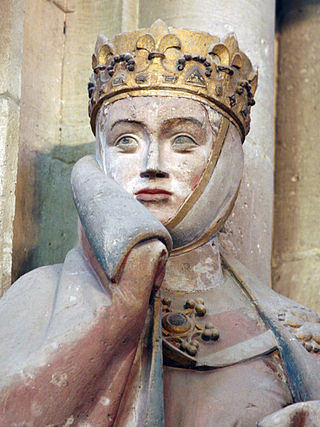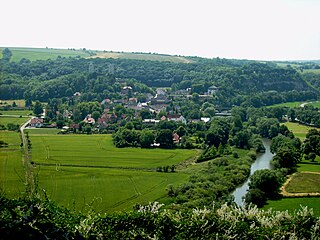
The House of Stammern, also Stammer, was an ancient, knightly, Saxon, aristocratic family.

The House of Stammern, also Stammer, was an ancient, knightly, Saxon, aristocratic family.
The family was first recorded in 1295 when a certain Conradus dictus Stammern was mentioned. The family had estates in Anhalt around and in Ballenstedt, and including Ermsleben, Görlsdorf, Polleben, Wedlitz, Westdorf and Wörmlitz. From 1420 they also owned Balgstädt. Bishop Henry of Stammer was dean (Stiftshauptmann) in Zeitz from 1471 to 1476 and sat in Plotha in 1482 and in Balgstädt in 1483. Adrian Arndt and Henning of Stammer were members of the Fruitbearing Society. In 1752 Carl Friedrich von Stammer was a member of the Naumburg Cathedral Chapter. Eckhardt August von Stammer (1772) was the commander (Landkomtur ) of the Kommende of Lucklum in the province or Ballei of Saxony within the Order of Teutonic Knights.
The coat of arms according to Siebmacher's Heraldry of 1605 shows a silver bend sinister on a red field. The mantling is red and silver. The crest is a sheaf of red pennons on golden shafts.

The Prince-Archbishopric of Bremen — not to be confused with the modern Archdiocese of Hamburg, founded in 1994 — was an ecclesiastical principality (787–1566/1648) of the Holy Roman Empire and the Catholic Church that after its definitive secularization in 1648 became the hereditary Duchy of Bremen. The prince-archbishopric, which was under the secular rule of the archbishop, consisted of about a third of the diocesan territory. The city of Bremen was de facto and de jure not part of the prince-archbishopric. Most of the prince-archbishopric lay rather in the area to the north of the city of Bremen, between the Weser and Elbe rivers. Even more confusingly, parts of the prince-archbishopric belonged in religious respect to the neighbouring Diocese of Verden, making up 10% of its diocesan territory.

Fritzlar is a small town in the Schwalm-Eder district in northern Hesse, Germany, 160 km (99 mi) north of Frankfurt, with a storied history.

The Duchy of Brunswick was a historical German state. Its capital was the city of Brunswick . It was established as the successor state of the Principality of Brunswick-Wolfenbüttel by the Congress of Vienna in 1815. In the course of the 19th-century history of Germany, the duchy was part of the German Confederation, the North German Confederation and from 1871 the German Empire. It was disestablished after the end of World War I, its territory incorporated into the Weimar Republic as the Free State of Brunswick.

Naumburg is a town in the district Burgenlandkreis, in the state of Saxony-Anhalt, Central Germany. It has a population of around 33,000. The Naumburg Cathedral became a UNESCO World Heritage Site in 2018. This UNESCO designation recognizes the processes that shaped the European continent during the High Middle Ages between 1000 and 1300: Christianization, the so-called "Landesausbau" and the dynamics of cultural exchange and transfer characteristic for this very period.

The Duchy of Saxe-Lauenburg, was a reichsfrei duchy that existed from 1296–1803 and again from 1814–1876 in the extreme southeast region of what is now Schleswig-Holstein. Its territorial center was in the modern district of Herzogtum Lauenburg and originally its eponymous capital was Lauenburg upon Elbe, though in 1619 the capital moved to Ratzeburg.

Augustus was Elector of Saxony from 1553 to 1586.

The House of Henneberg was a medieval German comital family (Grafen) which from the 11th century onwards held large territories in the Duchy of Franconia. Their county was raised to a princely county in 1310.
Conrad I, called the Great, a member of the House of Wettin, was Margrave of Meissen from 1123 and Margrave of Lusatia from 1136 until his retirement in 1156. Initially a Saxon count, he became the ruler over large Imperial estates in the Eastern March and progenitor of the Saxon electors and kings.

The House of Schönburg is an old European noble family of princely and historically sovereign rank. It formerly owned large properties in present-day Saxony, Thuringia and Bohemia. As a former ruling and mediatized family, it belongs to the Hochadel. The family today includes two princely and a comital branch.
Esico of Ballenstedt is the progenitor of the House of Ascania,. Esico was the count of Ballenstedt, and his possessions became the nucleus of the later Principality of Anhalt.

The Saxon Rebellion or Rebellion of the Saxons, also commonly called the Saxon Uprising, refers to the struggle between the Salian dynasty ruling the Holy Roman Empire and the rebel Saxons during the reign of Henry IV. The conflict reached its climax in the period from summer 1073 until the end of 1075, in a rebellion that involved several clashes of arms.
Hezilo of Hildesheim, also known as Hezelo, Hettilo or Ethilo, was Bishop of Hildesheim from 1054 to 1079.

Regenstein, also Reinstein, was a Lower Saxon noble family, which was named after the eponymous Regenstein Castle near Blankenburg on the edge of the Harz Mountains of central Germany.
Johann Rode von Wale was a Catholic cleric, a Doctor of Canon and Civil Law, a chronicler, a long-serving government official (1468–1497) and as John III Prince-archbishop of Bremen between 1497 and 1511.

Philip of the Palatinate was Prince-Bishop of Freising (1498–1541) and Naumburg (1517–1541). He was a member of the house of Wittelsbach, and the son of Elector Palatine Philip the Upright and Margaret of Bavaria. Among 14 children, he was the second oldest son. Several contemporary portraits of him are known.
John III of Schoenberg was from 1492 to 1517 Bishop of Naumburg-Zeitz.

Uta von Ballenstedt, a member of the House of Ascania, was Margravine of Meissen from 1038 until 1046, the wife of Margrave Eckard II. She is also called Uta of Naumburg as the subject of a famous donor portrait by the Naumburg Master.

The Naumburg Cathedral and the High Medieval Cultural Landscape of the Rivers Saale and Unstrut is situated in the state of Saxony-Anhalt, Germany. Naumburg Cathedral and the surrounding cultural landscape were proposed by Germany as a World Heritage Site. On July 1, 2018, only Naumburg Cathedral was designated by UNESCO as a World Heritage Site. This article discusses the cathedral and its cultural landscape based on the submissions in 1998 (cathedral) and 2005.

Saaleck is a village in the former municipality of Bad Kösen, since 2010 part of the town of Naumburg in the district of Burgenlandkreis in the German state of Saxony-Anhalt.